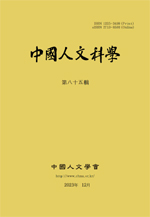공감각은 '상호 양태적 연관성의 무의식적인 경험'(Shen 2008)을 지칭하는 물리적 현상이다. 언어학에서 공감각 현상은 일반적으로 말해서 일상적인 언어들 속에서 하나의 감각 영역에서 다른 감각 영역으로의 은유적인 전이를 유발할 수 있는 흔한 종류의 은유 현상으로 이해된다. 예를 들어, '차가운 색'은 언어적으로 공감각적인데, 화자가 시각에 대한 인식을 촉각과 관련된 단어를 사용하여 표현하기 때문이다. 본 논문에서는 여러 언어와 방법론에 따라 진행되어 온 선행연구를 검토하면서 언어적 공감각, 즉 공감각적 은유에 대해 간략하게 소개한 후, 현대 중국어와 고대 중국어에서 수집된 공감각 자료에 대한 분석을 시도한다. 결론적으로 말해, 현대 및 고대 중국어의 자료 분석 결과는 중국어의 공감각 현상이 은유적 방향성에 대해 가장 널리 알려진 Ullmann(1957)의 연구와 다르다는 것을 보여준다. 이는 언어적 공감각 현상이 언어에 따라 또는 문화에 따라 특정적 변이를 가질 수 있음을 시사한다.
Synaesthesia is a physical phenomenon which refers to ‘the involuntary experience of a cross-modal association’ (Shen 2008). In linguistics, generally speaking, synaesthesia is considered as a common sort of metaphor in poetic and ordinary language which can make a metaphoric transfer from one sensory domain to another. For instance, ‘cold color’ is linguistically synaesthetic, because the speaker expresses a perception of vision by using a word related to touch. In this paper, I make a brief introduction to linguistic synaesthesia, namely, synaesthetic metaphor, based on previous studies in different languages and different methods, and then, attempt to analyze the synaesthetic data collected from modern and ancient Chinese. In conclusion, the data analysis results of both modern Mandarin Chinese and ancient Chinese show that the linguistic synaesthesia from Chinese is different from that from Ullmann’s (1957) study in the metaphoric directionality. It implies that linguistic synaesthesia could have language- or culture-specific variations as per language.
Ⅰ. 引言
Ⅱ. 文獻評論
Ⅲ. 現代漢語的通感
Ⅳ. 古漢語的通感
Ⅴ. 綜合分析討論
Ⅵ. 結語
(0)
(0)
